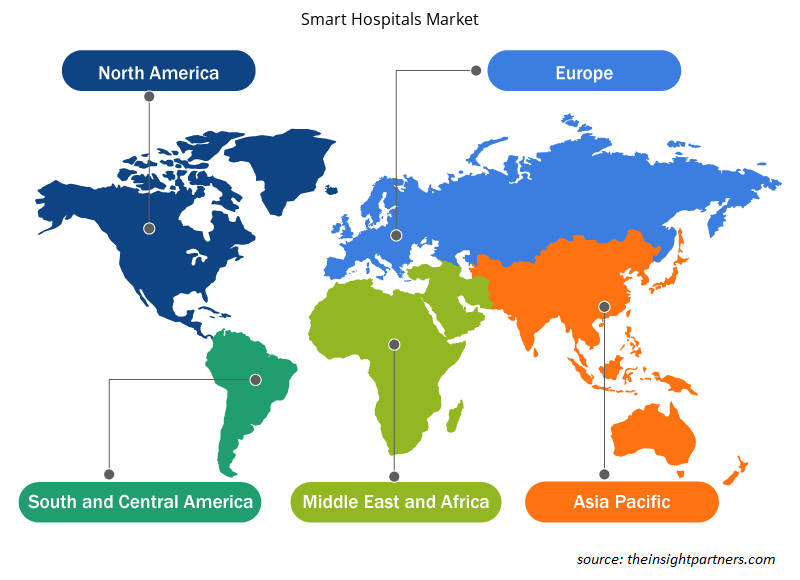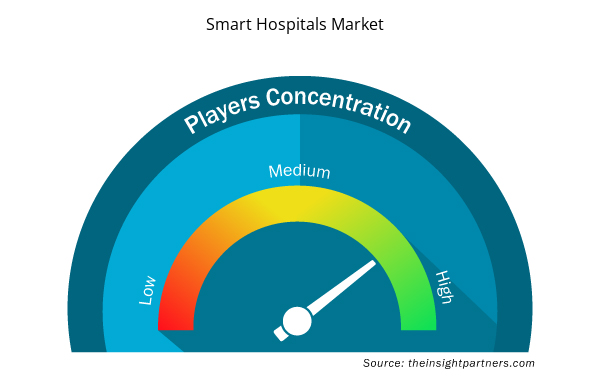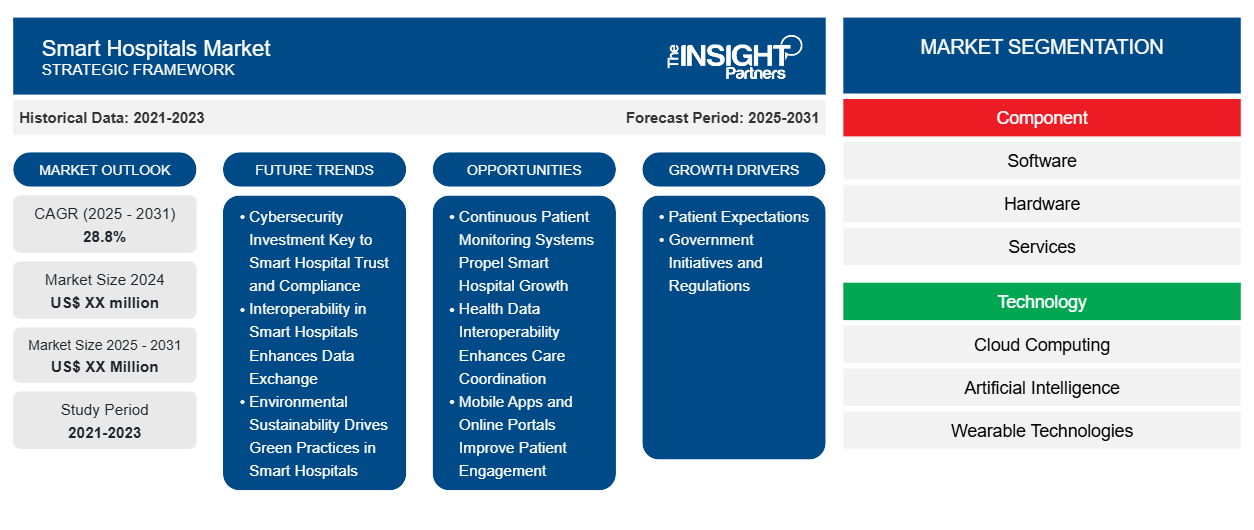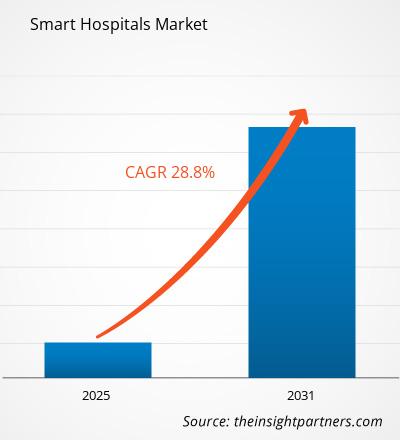Le marché des hôpitaux intelligents devrait enregistrer un TCAC de 28,8 % de 2024 à 2031, avec une taille de marché passant de XX millions USD en 2024 à XX millions USD d'ici 2031.CAGR of 28.8% from 2024 to 2031, with a market size expanding from US$ XX million in 2024 to US$ XX Million by 2031.
Le rapport sur le marché des hôpitaux intelligents couvre l’analyse par composant, technologie, application, connectivité et géographie.
Objectif du rapport
Le rapport Smart Hospitals Market de The Insight Partners vise à décrire le paysage actuel et la croissance future, les principaux facteurs moteurs, les défis et les opportunités. Cela fournira des informations à diverses parties prenantes commerciales, telles que :
- Fournisseurs/fabricants de technologie : pour comprendre l’évolution de la dynamique du marché et connaître les opportunités de croissance potentielles, leur permettant de prendre des décisions stratégiques éclairées.
- Investisseurs : Effectuer une analyse complète des tendances concernant le taux de croissance du marché, les projections financières du marché et les opportunités qui existent tout au long de la chaîne de valeur.
- Organismes de réglementation : Réglementer les politiques et surveiller les activités du marché dans le but de minimiser les abus, de préserver la confiance des investisseurs et de maintenir l’intégrité et la stabilité du marché.
Segmentation du marché des hôpitaux intelligents
Composant
- Logiciel
- Matériel
- Services
Technologie
- Cloud Computing
- Intelligence artificielle
- Technologies portables
- Identification des radiofréquences
- Autres
Application
- Gestion de la médecine à distance
- Imagerie médicale connectée
- Assistance médicale
- Dossier médical électronique et flux de travail clinique
- Vigilance ambulatoire
Connectivité
- Câblé
- Sans fil
Personnalisez ce rapport en fonction de vos besoins
Vous bénéficierez d'une personnalisation gratuite de n'importe quel rapport, y compris de certaines parties de ce rapport, d'une analyse au niveau des pays, d'un pack de données Excel, ainsi que de superbes offres et réductions pour les start-ups et les universités.
- Obtenez les principales tendances clés du marché de ce rapport.Cet échantillon GRATUIT comprendra une analyse de données, allant des tendances du marché aux estimations et prévisions.
Facteurs de croissance du marché des hôpitaux intelligents
- Attentes des patients : L’émergence de fortes attentes de la part des patients en matière de qualité et de soins personnalisés nécessite la mise en place d’hôpitaux intelligents pour répondre aux nouvelles demandes. Ce changement contribue à une croissance massive du marché car le marché international connaît une augmentation des investissements visant à promouvoir l’engagement des patients. L’analyse du marché indique que les hôpitaux qui adoptent ces technologies intelligentes occuperont une plus grande part de marché, améliorant ainsi l’innovation dans la prestation de services et les soins de santé en général.
- Initiatives et réglementations gouvernementales : les initiatives gouvernementales et les cadres réglementaires qui encouragent l’innovation dans le domaine des soins de santé sont essentiels pour faire progresser le marché des hôpitaux intelligents. Les politiques qui amélioreraient l’efficacité des soins de santé et les résultats des patients sont probablement ce qui encouragerait les investisseurs dans les technologies intelligentes. C’est pourquoi l’aperçu du marché pour ce segment de marché sera plus optimiste, avec une perspective de croissance soutenue par des réglementations positives. Les tendances de croissance se feront sentir à mesure que l’industrie mondiale réagira en gagnant des parts de marché grâce aux entreprises qui investissent dans des solutions de santé numériques, comme le reflètent les récents rapports de marché et les analyses des tendances du secteur.
Tendances futures du marché des hôpitaux intelligents
- L’investissement en cybersécurité est essentiel pour la confiance et la conformité des hôpitaux intelligents : avec la numérisation croissante des hôpitaux intelligents, la cybersécurité est au centre des préoccupations. La protection des données sensibles des patients a toujours été très importante, d’où l’investissement accru des prestataires de soins de santé dans des mesures de cybersécurité robustes. Cela ouvre la voie aux entreprises qui peuvent proposer des solutions dans le domaine de la cybersécurité et entreprendre des collaborations avec les prestataires de soins de santé. Alors que la stratégie du marché évolue vers des protocoles de sécurité holistiques, cela est très important pour maintenir la confiance des patients et leur conformité. Cette tendance constitue l’épine dorsale d’un système hospitalier intelligent résilient face aux cybermenaces.
- L'interopérabilité dans les hôpitaux intelligents améliore l'échange de données : L'interopérabilité dans les hôpitaux intelligents gagne en importance à mesure que les systèmes de santé poursuivent leur quête d'un échange de données sans douleur. La nouvelle tendance favorise l'interopérabilité et améliore les résultats des patients entre les prestataires de soins de santé. Selon l'analyse PEST, les pressions réglementaires sur les formats standardisés des données ont stimulé l'innovation. Les principaux acteurs ont travaillé sur des stratégies de marché en proposant des solutions interopérables qui permettraient un meilleur partage des données, influençant ainsi positivement la dynamique du marché et garantissant le respect des soins appropriés aux patients.
- La durabilité environnementale favorise les pratiques écologiques dans les hôpitaux intelligents : La sensibilisation à la durabilité environnementale oblige les hôpitaux intelligents à adopter des pratiques respectueuses de l'environnement. Cela comprend des infrastructures économes en énergie et des programmes de réduction des déchets, qui deviennent progressivement partie intégrante du fonctionnement de l'hôpital. Une analyse PEST attire l'attention sur le cadre juridique en place pour la poursuite de la durabilité dans les soins de santé. Les tendances générales du marché reçoivent en effet des implications positives de la part des principaux acteurs sur la base des stratégies de marché axées sur les technologies vertes et les pratiques durables. À cet égard, les hôpitaux intelligents améliorent non seulement leurs performances en tant qu'unités opérationnelles, mais préservent également l'image publique et la satisfaction des patients.
Opportunités de marché pour les hôpitaux intelligents
- Les systèmes de surveillance continue des patients stimulent la croissance des hôpitaux intelligents : Le système de surveillance continue des patients représente un secteur de croissance important pour les hôpitaux intelligents. C'est pour cette raison qu'une analyse concurrentielle indique que les hôpitaux basés en Amérique du Nord qui investissent dans ces technologies seront bien placés pour se démarquer dans le paysage de l'industrie, car ils répondent aux attentes croissantes en matière de gestion proactive des soins de santé.
- L’interopérabilité des données de santé améliore la coordination des soins : le besoin d’interopérabilité des données de santé crée une opportunité intéressante pour les hôpitaux intelligents dans les secteurs en croissance. Les systèmes interopérables garantiront que les informations sont partagées de manière transparente entre les prestataires et, par conséquent, amélioreront la coordination et les résultats des soins. Cette initiative est particulièrement nécessaire en Amérique du Nord, car ses systèmes de santé fragmentent les patients et ont créé des problèmes lors de leur gestion.
- Les applications mobiles et les portails en ligne améliorent l'engagement des patients : grâce aux applications mobiles et aux portails en ligne, les patients peuvent mieux gérer leur parcours de santé. C'est également essentiel dans le secteur nord-américain, où les préférences des patients évoluent continuellement, passant d'une prestation de soins de santé moins interactive à une expérience plus interactive. Une analyse concurrentielle détaillée montre que les hôpitaux « orientés vers l'engagement des patients » peuvent se distinguer dans le secteur de la santé, qui s'avère relativement plus impressionnant en termes de satisfaction des patients, et donc de fidélisation à long terme des patients.
Aperçu régional du marché des hôpitaux intelligents
Les tendances et facteurs régionaux influençant le marché des hôpitaux intelligents tout au long de la période de prévision ont été expliqués en détail par les analystes d’Insight Partners. Cette section traite également des segments et de la géographie du marché des hôpitaux intelligents en Amérique du Nord, en Europe, en Asie-Pacifique, au Moyen-Orient et en Afrique, ainsi qu’en Amérique du Sud et en Amérique centrale.

- Obtenez les données régionales spécifiques au marché des hôpitaux intelligents
Portée du rapport sur le marché des hôpitaux intelligents
| Attribut de rapport | Détails |
|---|---|
| Taille du marché en 2024 | XX millions de dollars américains |
| Taille du marché d'ici 2031 | XX millions de dollars américains |
| Taux de croissance annuel composé mondial (2025-2031) | 28,8% |
| Données historiques | 2021-2023 |
| Période de prévision | 2025-2031 |
| Segments couverts | Par composant
|
| Régions et pays couverts | Amérique du Nord
|
| Leaders du marché et profils d'entreprises clés |
|
Densité des acteurs du marché des hôpitaux intelligents : comprendre son impact sur la dynamique commerciale
Le marché des hôpitaux intelligents connaît une croissance rapide, tirée par la demande croissante des utilisateurs finaux en raison de facteurs tels que l'évolution des préférences des consommateurs, les avancées technologiques et une plus grande sensibilisation aux avantages du produit. À mesure que la demande augmente, les entreprises élargissent leurs offres, innovent pour répondre aux besoins des consommateurs et capitalisent sur les tendances émergentes, ce qui alimente davantage la croissance du marché.
La densité des acteurs du marché fait référence à la répartition des entreprises ou des sociétés opérant sur un marché ou un secteur particulier. Elle indique le nombre de concurrents (acteurs du marché) présents sur un marché donné par rapport à sa taille ou à sa valeur marchande totale.
Les principales entreprises opérant sur le marché des hôpitaux intelligents sont :
- Stanley Soins de santé
- Qualcomm Technologies, Inc.
- Royal Philips NV
- Allscripts Healthcare, LLC
- Société McKesson
Avis de non-responsabilité : les sociétés répertoriées ci-dessus ne sont pas classées dans un ordre particulier.

- Obtenez un aperçu des principaux acteurs du marché des hôpitaux intelligents
Principaux arguments de vente
- Couverture complète : Le rapport couvre de manière exhaustive l’analyse des produits, des services, des types et des utilisateurs finaux du marché des hôpitaux intelligents, offrant un paysage holistique.
- Analyse d’experts : Le rapport est compilé sur la base d’une compréhension approfondie des experts et analystes du secteur.
- Informations à jour : Le rapport garantit la pertinence commerciale en raison de sa couverture des informations récentes et des tendances des données.
- Options de personnalisation : ce rapport peut être personnalisé pour répondre aux exigences spécifiques du client et s'adapter parfaitement aux stratégies commerciales.
Le rapport de recherche sur le marché des hôpitaux intelligents peut donc aider à ouvrir la voie au décodage et à la compréhension du scénario de l’industrie et des perspectives de croissance. Bien qu’il puisse y avoir quelques préoccupations valables, les avantages globaux de ce rapport ont tendance à l’emporter sur les inconvénients.
- Analyse historique (2 ans), année de base, prévision (7 ans) avec TCAC
- Analyse PEST et SWO
- Taille du marché Valeur / Volume - Mondial, Régional, Pays
- Industrie et paysage concurrentiel
- Ensemble de données Excel



Report Coverage
Revenue forecast, Company Analysis, Industry landscape, Growth factors, and Trends

Segment Covered
This text is related
to segments covered.

Regional Scope
North America, Europe, Asia Pacific, Middle East & Africa, South & Central America

Country Scope
This text is related
to country scope.
Questions fréquemment posées
Some of the customization options available based on request are additional 3-5 company profiles and country-specific analysis of 3-5 countries of your choice. Customizations are to be requested/discussed before making final order confirmation, as our team would review the same and check the feasibility.
The report can be delivered in PDF/PPT format; we can also share excel dataset based on the request.
Key companies in this market are: Stanley Healthcare, Qualcomm Technologies Inc, Koninklijke Philips N V, Allscripts Healthcare LLC, McKesson Corporation, Cerner Corporation, Honeywell International Inc, GE Healthcare, SAP SE
The Smart Hospitals Market is expected to register a CAGR of 28.8% from 2023-2031.
Key future trends in this market are - Integration of IoT technologies, Growth in patient-centered care, Adoption of AI-driven solutions
The major factors impacting the Smart Hospitals Market are: Regulatory Support, Increasing Patient Demand, and Technological Advancements
Trends and growth analysis reports related to Technology, Media and Telecommunications : READ MORE..
1. Stanley Healthcare
2. Qualcomm Technologies, Inc.
3. Koninklijke Philips N.V.
4. Allscripts Healthcare, LLC
5. McKesson Corporation
6. Cerner Corporation
7. Honeywell International Inc.
8. GE Healthcare
9. SAP SE
10. Cognizant
11. Medtronic
12. Honeywell Life Care Solutions
13. Microsoft
14. Diabetizer
15. Proteus Digital Health
16. AdhereTECH
17. PhysIQ
18. IQVIA
19. Wipro Limited
20. SCIOInspire, Corp
The Insight Partners performs research in 4 major stages: Data Collection & Secondary Research, Primary Research, Data Analysis and Data Triangulation & Final Review.
- Data Collection and Secondary Research:
As a market research and consulting firm operating from a decade, we have published and advised several client across the globe. First step for any study will start with an assessment of currently available data and insights from existing reports. Further, historical and current market information is collected from Investor Presentations, Annual Reports, SEC Filings, etc., and other information related to company’s performance and market positioning are gathered from Paid Databases (Factiva, Hoovers, and Reuters) and various other publications available in public domain.
Several associations trade associates, technical forums, institutes, societies and organization are accessed to gain technical as well as market related insights through their publications such as research papers, blogs and press releases related to the studies are referred to get cues about the market. Further, white papers, journals, magazines, and other news articles published in last 3 years are scrutinized and analyzed to understand the current market trends.
- Primary Research:
The primarily interview analysis comprise of data obtained from industry participants interview and answers to survey questions gathered by in-house primary team.
For primary research, interviews are conducted with industry experts/CEOs/Marketing Managers/VPs/Subject Matter Experts from both demand and supply side to get a 360-degree view of the market. The primary team conducts several interviews based on the complexity of the markets to understand the various market trends and dynamics which makes research more credible and precise.
A typical research interview fulfils the following functions:
- Provides first-hand information on the market size, market trends, growth trends, competitive landscape, and outlook
- Validates and strengthens in-house secondary research findings
- Develops the analysis team’s expertise and market understanding
Primary research involves email interactions and telephone interviews for each market, category, segment, and sub-segment across geographies. The participants who typically take part in such a process include, but are not limited to:
- Industry participants: VPs, business development managers, market intelligence managers and national sales managers
- Outside experts: Valuation experts, research analysts and key opinion leaders specializing in the electronics and semiconductor industry.
Below is the breakup of our primary respondents by company, designation, and region:

Once we receive the confirmation from primary research sources or primary respondents, we finalize the base year market estimation and forecast the data as per the macroeconomic and microeconomic factors assessed during data collection.
- Data Analysis:
Once data is validated through both secondary as well as primary respondents, we finalize the market estimations by hypothesis formulation and factor analysis at regional and country level.
- Macro-Economic Factor Analysis:
We analyse macroeconomic indicators such the gross domestic product (GDP), increase in the demand for goods and services across industries, technological advancement, regional economic growth, governmental policies, the influence of COVID-19, PEST analysis, and other aspects. This analysis aids in setting benchmarks for various nations/regions and approximating market splits. Additionally, the general trend of the aforementioned components aid in determining the market's development possibilities.
- Country Level Data:
Various factors that are especially aligned to the country are taken into account to determine the market size for a certain area and country, including the presence of vendors, such as headquarters and offices, the country's GDP, demand patterns, and industry growth. To comprehend the market dynamics for the nation, a number of growth variables, inhibitors, application areas, and current market trends are researched. The aforementioned elements aid in determining the country's overall market's growth potential.
- Company Profile:
The “Table of Contents” is formulated by listing and analyzing more than 25 - 30 companies operating in the market ecosystem across geographies. However, we profile only 10 companies as a standard practice in our syndicate reports. These 10 companies comprise leading, emerging, and regional players. Nonetheless, our analysis is not restricted to the 10 listed companies, we also analyze other companies present in the market to develop a holistic view and understand the prevailing trends. The “Company Profiles” section in the report covers key facts, business description, products & services, financial information, SWOT analysis, and key developments. The financial information presented is extracted from the annual reports and official documents of the publicly listed companies. Upon collecting the information for the sections of respective companies, we verify them via various primary sources and then compile the data in respective company profiles. The company level information helps us in deriving the base number as well as in forecasting the market size.
- Developing Base Number:
Aggregation of sales statistics (2020-2022) and macro-economic factor, and other secondary and primary research insights are utilized to arrive at base number and related market shares for 2022. The data gaps are identified in this step and relevant market data is analyzed, collected from paid primary interviews or databases. On finalizing the base year market size, forecasts are developed on the basis of macro-economic, industry and market growth factors and company level analysis.
- Data Triangulation and Final Review:
The market findings and base year market size calculations are validated from supply as well as demand side. Demand side validations are based on macro-economic factor analysis and benchmarks for respective regions and countries. In case of supply side validations, revenues of major companies are estimated (in case not available) based on industry benchmark, approximate number of employees, product portfolio, and primary interviews revenues are gathered. Further revenue from target product/service segment is assessed to avoid overshooting of market statistics. In case of heavy deviations between supply and demand side values, all thes steps are repeated to achieve synchronization.
We follow an iterative model, wherein we share our research findings with Subject Matter Experts (SME’s) and Key Opinion Leaders (KOLs) until consensus view of the market is not formulated – this model negates any drastic deviation in the opinions of experts. Only validated and universally acceptable research findings are quoted in our reports.
We have important check points that we use to validate our research findings – which we call – data triangulation, where we validate the information, we generate from secondary sources with primary interviews and then we re-validate with our internal data bases and Subject matter experts. This comprehensive model enables us to deliver high quality, reliable data in shortest possible time.


 Obtenez un échantillon gratuit pour ce rapport
Obtenez un échantillon gratuit pour ce rapport